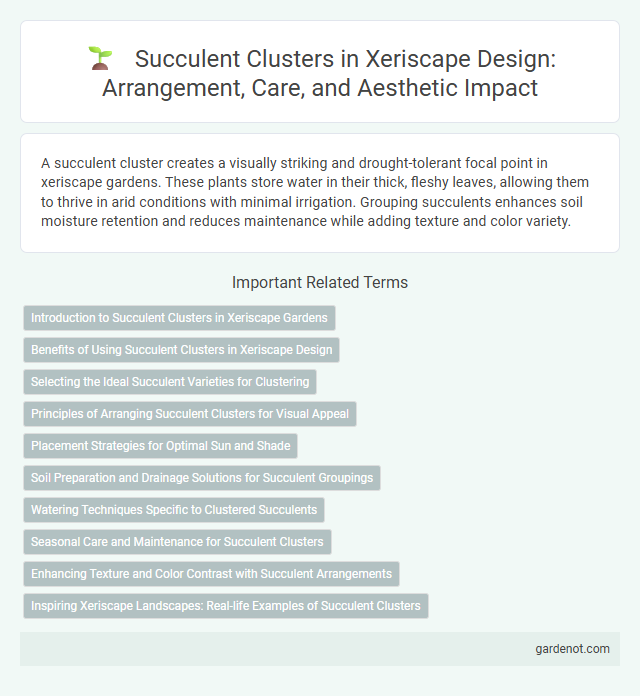A succulent cluster creates a visually striking and drought-tolerant focal point in xeriscape gardens. These plants store water in their thick, fleshy leaves, allowing them to thrive in arid conditions with minimal irrigation. Grouping succulents enhances soil moisture retention and reduces maintenance while adding texture and color variety.
Introduction to Succulent Clusters in Xeriscape Gardens
Succulent clusters in xeriscape gardens offer drought-tolerant, low-maintenance solutions by grouping species like echeverias, sedums, and agaves that store water efficiently in their leaves. These resilient plants thrive in arid conditions, reducing irrigation needs and promoting sustainable landscaping practices. Arranging succulents in dense clusters enhances soil moisture retention and creates visually appealing textures with varying shapes and colors.
Benefits of Using Succulent Clusters in Xeriscape Design
Succulent clusters in xeriscape design enhance water efficiency by storing moisture in their thick leaves, reducing irrigation needs significantly. Their diverse textures and vibrant colors create visually appealing landscapes that thrive in arid conditions while suppressing weed growth naturally. These low-maintenance plants contribute to soil stabilization and promote biodiversity by attracting pollinators such as bees and butterflies.
Selecting the Ideal Succulent Varieties for Clustering
Selecting the ideal succulent varieties for clustering involves choosing species with complementary growth habits, colors, and textures to create a harmonious xeriscape display. Opt for drought-tolerant succulents like Echeveria, Sedum, and Aloe that thrive in similar soil and light conditions, ensuring sustainability and visual appeal. Grouping succulents with varying heights and leaf shapes enhances depth and interest while maintaining low water usage in xeriscape environments.
Principles of Arranging Succulent Clusters for Visual Appeal
Succulent clusters should be arranged by combining varying shapes, sizes, and colors to create depth and visual interest. Use principles like grouping similar species together while maintaining contrast through texture and height for balanced composition. Incorporate focal points with unique or brightly colored succulents to draw the viewer's eye and enhance the overall aesthetic of the xeriscape.
Placement Strategies for Optimal Sun and Shade
Succulent clusters thrive when placed in locations that balance direct sunlight with partial shade, ensuring protection from intense afternoon rays that can cause sunburn. Grouping succulents with similar light requirements enhances their growth and reduces water stress, while strategic placement near taller plants or structures provides beneficial dappled shade. Optimal placement within xeriscape designs maximizes photosynthesis efficiency and water conservation, promoting vibrant, resilient succulent clusters.
Soil Preparation and Drainage Solutions for Succulent Groupings
Succulent clusters thrive in well-draining soil rich in organic matter and coarse sand to prevent water retention and root rot. Incorporating gravel or pumice within the soil mixture enhances aeration and promotes rapid drainage, essential for maintaining healthy succulent groupings. Installing drainage layers such as crushed stone at the base of planting containers further ensures excess water is efficiently removed, preventing stagnant moisture around roots.
Watering Techniques Specific to Clustered Succulents
Succulent clusters require careful watering techniques to prevent overhydration and root rot, focusing on deep watering that encourages roots to grow downward. Allow the soil to dry out completely between waterings, especially in the spaces between clustered plants, to ensure optimal moisture absorption and reduce fungal infections. Utilizing well-draining soil and observing the cluster's overall moisture needs supports healthy growth and conserves water efficiently in xeriscape landscapes.
Seasonal Care and Maintenance for Succulent Clusters
Succulent clusters require minimal watering, especially during their dormant winter months, to prevent root rot and promote healthy growth. Regular inspection for pests like mealybugs and aphids ensures early detection and treatment, preserving the cluster's vitality. Seasonal pruning and removal of dead leaves enhance air circulation and maintain the aesthetic appeal of the succulent grouping.
Enhancing Texture and Color Contrast with Succulent Arrangements
Succulent clusters create striking texture and color contrast by combining diverse species such as Echeveria, Sedum, and Crassula, which exhibit varied leaf shapes and hues ranging from deep purples to vibrant greens. Arranging succulents with contrasting textures, like the rosette form of Echeveria alongside the spiky Acropora, enhances visual interest in xeriscaped gardens. Strategic placement of colorful succulents like Aeonium 'Zwartkop' and bright green Haworthia intensifies color contrast, promoting eye-catching, water-efficient landscaping.
Inspiring Xeriscape Landscapes: Real-life Examples of Succulent Clusters
Succulent clusters transform xeriscape landscapes by showcasing drought-resistant plants like agave, echeveria, and sedum that thrive in arid conditions. These clusters create visually striking patterns with diverse textures and vibrant colors, minimizing water use while maximizing aesthetic appeal. Real-life examples from regions such as Arizona and Southern California highlight how succulent clusters enhance eco-friendly garden design with low-maintenance, high-impact greenery.
Succulent cluster Infographic

 gardenot.com
gardenot.com